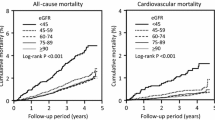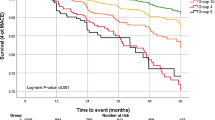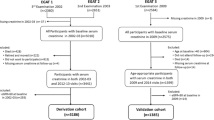Abstract
Purpose
This study’s purpose was to examine established cardiovascular risk prediction model scores for their associations with albuminuria and estimated glomerular filtration rate (eGFR) in Korean population.
Methods
We calculated the 10-year atherosclerotic cardiovascular disease (ASCVD) risk estimated score, Korean coronary heart disease risk prediction score (KRS), and the Adult Treatment Panel (ATP) III risk score for 9733 South Koreans, aged 40–79 years, who were not diagnosed with stroke, angina pectoris, or myocardial ischemia using data from the 2011–2013 Korea National Health and Nutrition Examination Survey.
Results
The associations between cardiovascular risk model scores and the urine albumin-to-creatinine ratio (UACR) and eGFR tended to be stronger for the ASCVD risk score than for the other risk scores. The area under the receiver operating characteristic curve for increased albuminuria (UACR ≥ 30 mg/g) and decreased eGFR (<60 mL/min/1.73 m2) was significantly higher for the ASCVD risk score than for the ATP III risk score and the KRS (except for increased albuminuria in women).
Conclusions
The ASCVD risk score had a stronger relationship with and better predicted albuminuria and eGFR than did the KRS and ATP III risk score.
Similar content being viewed by others
References
Komenda P, Rigatto C, Tangri N (2014) Estimated glomerular filtration rate and albuminuria: diagnosis, staging, and prognosis. Curr Opin Nephrol Hypertens 23:251–257
Chronic Kidney Disease Prognosis Consortium, Matsushita K, van der Velde M et al (2010) Association of estimated glomerular filtration rate and albuminuria with all-cause and cardiovascular mortality in general population cohorts: a collaborative meta-analysis. Lancet 375:2073–2081
van der Velde M, Matsushita K, Coresh J et al (2011) Lower estimated glomerular filtration rate and higher albuminuria are associated with all-cause and cardiovascular mortality. A collaborative meta-analysis of high-risk population cohorts. Kidney Int 79:1341–1352
Matsushita K, Coresh J, Sang Y, CKD Prognosis Consortium et al (2015) Estimated glomerular filtration rate and albuminuria for prediction of cardiovascular outcomes: a collaborative meta-analysis of individual participant data. Lancet Diabetes Endocrinol 3:514–525
Jin B, Bai X, Han L, Liu J, Zhang W, Chen X (2014) Association between kidney function and Framingham global cardiovascular disease risk score: a Chinese longitudinal study. PLoS One 9:e86082
Hong JW, Ku CR, Noh JH, Ko KS, Rhee BD, Kim DJ (2015) Association between low-grade albuminuria and cardiovascular risk in Korean adults: the 2011–2012 Korea National Health and Nutrition Examination Survey. PLoS One 10:e0118866
Asselbergs FW, Hillege HL, van Gilst WH (2004) Framingham score and microalbuminuria: combined future targets for primary prevention? Kidney Int Suppl 92:S111–S114
Chang A, Kramer H (2011) Should eGFR and albuminuria be added to the Framingham risk score? Chronic kidney disease and cardiovascular disease risk prediction. Nephron Clin Pract 119:c171–c177
Stone NJ, Robinson JG, Lichtenstein AH, American College of Cardiology/American Heart Association Task Force on Practice Guidelines et al (2014) 2013 ACC/AHA guideline on the treatment of blood cholesterol to reduce atherosclerotic cardiovascular risk in adults: a report of the American College of Cardiology/American Heart Association Task Force on Practice Guidelines. Circulation 129:S1–S45
Jee SH, Jang Y, Oh DJ et al (2014) A coronary heart disease prediction model: the Korean Heart Study. BMJ Open 4:e005025-2014-005025
Korea Centers for Disease Control and Prevention, Ministry of Health and Welfare. Korea health statistics 2010-2012: The Fifth Korea National Health and Nutrition Examination Survey (KNHANES V) [internet]. 2013. https://knhanes.cdc.go.kr/knhanes/index.do
Korea Centers for Disease Control and Prevention, Ministry of Health and Welfare. Korea health statistics 2013: The Sixth Korea National Health and Nutrition Examination Survey (KNHANES VI-1) [internet]. 2014. https://knhanes.cdc.go.kr/knhanes/index.do
Expert Panel on Detection, Evaluation, and Treatment of High Blood Cholesterol in Adults (2001) Executive summary of the third report of the National Cholesterol Education Program (NCEP) Expert panel on detection, evaluation, and treatment of high blood cholesterol in adults (Adult Treatment Panel III). JAMA 285:2486–2497
Korea Centers for Disease Control and Prevention. Guidelines for using the Fifth National Health and Nutrition Examination Survey (KNHANES V-1), 2010 In Osong, Chungcheong Buk-Do, Republic of Korea, Korea Centers for Disease Control and Prevention. 2011
Korea Centers for Disease Control and Prevention. Guidelines for using the third year, Fourth National Health and Nutrition Examination Survey (KNHANES IV), 2009 In, Osong, Chungcheong Buk-Do, Republic of Korea, Korea Centers for Disease Control and Prevention. 2010
Levey AS, Stevens LA, Schmid CH, CKD-EPI (Chronic Kidney Disease Epidemiology Collaboration) (2009) A new equation to estimate glomerular filtration rate. Ann Intern Med 150:604–612
Kidney Disease: Improving Global Outcomes (KDIGO) CKD Work Group (2013) KDIGO 2012 clinical practice guideline for the evaluation and management of chronic kidney disease. Kidney Int Suppl 13:1–150
Ruggenenti P, Remuzzi G (2006) Time to abandon microalbuminuria? Kidney Int 70:1214–1222
Hillege HL, Fidler V, Diercks GF, Prevention of Renal and Vascular End Stage Disease (PREVEND) Study Group et al (2002) Urinary albumin excretion predicts cardiovascular and noncardiovascular mortality in general population. Circulation 106:1777–1782
Cook NR (2008) Statistical evaluation of prognostic versus diagnostic models: beyond the ROC curve. Clin Chem 54:17–23
KDOQI (2007) KDOQI clinical practice guidelines and clinical practice recommendations for diabetes and chronic kidney disease. Am J Kidney Dis 49:S12–S154
Lamb EJ, MacKenzie F, Stevens PE (2009) How should proteinuria be detected and measured? Ann Clin Biochem 46:205–217
Viswanathan G, Upadhyay A (2011) Assessment of proteinuria. Adv Chronic Kidney Dis 18:243–248
Jung KJ, Jang Y, Oh DJ et al (2015) The ACC/AHA 2013 pooled cohort equations compared to a Korean Risk Prediction Model for atherosclerotic cardiovascular disease. Atherosclerosis 242:367–375
Author information
Authors and Affiliations
Corresponding author
Ethics declarations
Conflict of interest
K. Lee declares that she has no conflict of interest. J. Kim declares that he has no conflict of interest.
Ethical approval
All procedures performed in studies involving human participants were in accordance with the ethical standards of the institutional research committee and with the 1964 Helsinki Declaration and its later amendments or comparable ethical standards. The KNHANES was conducted with ethical approval from the Institutional Review Board of the Korea Center for Disease Control and Prevention (Nos: 2012-01EXP-01-2C, 2013-07CON-03-4C).
Informed consent
Informed consent was obtained from all individual participants included in the study.
Rights and permissions
About this article
Cite this article
Lee, K., Kim, J. Estimated glomerular filtration rate and albuminuria in Korean population evaluated for cardiovascular risk. Int Urol Nephrol 48, 759–764 (2016). https://doi.org/10.1007/s11255-016-1244-9
Received:
Accepted:
Published:
Issue Date:
DOI: https://doi.org/10.1007/s11255-016-1244-9




